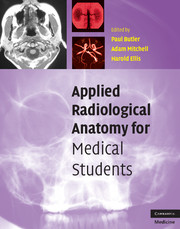Book contents
6 - The renal tract, retroperitoneum and pelvis
Published online by Cambridge University Press: 12 November 2009
Summary
Imaging methods
The gross bony anatomy of the pelvis, as well as the detailed trabecular pattern of bone, is well demonstrated on conventional radiographs. CT provides superior three-dimensional spatial relationships, for example, in the demonstration of bone fragments in pelvic fractures or the position of a ureteric calculus. MRI provides unique information regarding bone marrow components such as fat, hemopoietic tissue, and bone marrow pathology. The soft tissues of the renal tract and pelvis are demonstrated using ultrasound, CT, and MRI, which all provide complementary information. Ultrasound and MRI have the advantage of not utilizing ionizing radiation. Ultrasound is the first imaging modality used to assess the kidneys and renal tract as a basic screen, due to its easy accessibility, lack of radiation, and low cost. In the pelvis, a full bladder is needed to act as an acoustic window and to displace gas-filled loops of bowel out of the pelvis. Endovaginal and transrectal ultrasound, though invasive, can provide exquisite detail of the internal anatomy of the female genital tract, male prostate and seminal vesicles without the necessity of a full bladder. MRI provides similar detail. The hysterosalpingogram (HSG) still has an important role in the evaluation of the uterine cavity and Fallopian tubes.
Arteriography and venography are the gold standards for demonstrating the vasculature of the retroperitoneum and pelvis, although MRI and contrast-enhanced CT (particularly multidetector CT) are used increasingly as non-invasive angiographic techniques.
The urinary tract is also investigated using iodinated contrast studies. These include the intravenous urogram (IVU) and the micturating cystourethrogram (MCUG). The former will normally demonstrate the pelvicalyceal systems, lower ureters, and the full bladder outline, whereas the MCUG demonstrates the entire urethra during micturition.
- Type
- Chapter
- Information
- Applied Radiological Anatomy for Medical Students , pp. 47 - 63Publisher: Cambridge University PressPrint publication year: 2007



